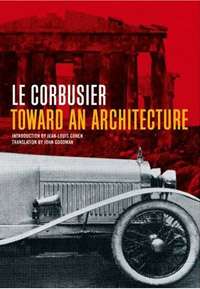Le Corbusier's Five Points of Architecture
Le Corbusier's Five Points of Architecture is an architecture manifesto by architect Le Corbusier.[1] It was authored in L'Esprit Nouveau and his book Vers une architecture.
Five Points of Architecture
During his career, Le Corbusier developed a set of architectural principles that dictated his technique, which he called "the Five Points of a New Architecture" and were most evident in his Villa Savoye. The five points are:
- Pilotis – Replacement of supporting walls by a grid of reinforced concrete columns that bears the structural load is the basis of the new aesthetic.
- The free designing of the ground plan—the absence of supporting walls—means the house is unrestrained in its internal use.
- The free design of the façade—separating the exterior of the building from its structural function—sets the façade free from structural constraints.
- The horizontal window, which cuts the façade along its entire length, lights rooms equally.
- Roof gardens on a flat roof can serve a domestic purpose while providing essential protection to the concrete roof.[2]
Villa Savoye
It was Le Corbusier's Villa Savoye (1929–1931) that most succinctly summed up his five points of architecture that he had elucidated in the journal L'Esprit Nouveau and his book Vers une architecture, which he had been developing throughout the 1920s. First, Le Corbusier lifted the bulk of the structure off the ground, supporting it by pilotis – reinforced concrete stilts. These pilotis, in providing the structural support for the house, allowed him to elucidate his next two points: a free façade, meaning non-supporting walls that could be designed as the architect wished, and an open floor plan, meaning that the floor space was free to configure into rooms without concern for supporting walls. The second floor of the Villa Savoye includes long strips of ribbon windows that allow unencumbered views of the large surrounding yard, and constitute the fourth point of his system. The fifth point was the roof garden to compensate for the green area consumed by the building and replacing it on the roof. A ramp rising from ground level to the third floor roof terrace allows for an architectural promenade through the structure. The white tubular railing recalls the industrial "ocean-liner" aesthetic that Le Corbusier much admired. The driveway around the ground floor, with its semicircular path, measures the exact turning radius of a 1927 Citroën automobile.
Carpenter Center
The Carpenter Center for the Visual Arts at Harvard University was Le Corbusier's only building in the United States, and he aimed to incorporate his Five Points into the design of the building.[3]
References
- ↑ http://www.nzherald.co.nz/opinion/news/article.cfm?c_id=466&objectid=10862664
- ↑ Le Corbusier (1986). Towards a New Architecture. Mineola, NY: Dover Publications, Inc.
- ↑ Sekler (1978). Le Corbusier at Work. p. 2.


